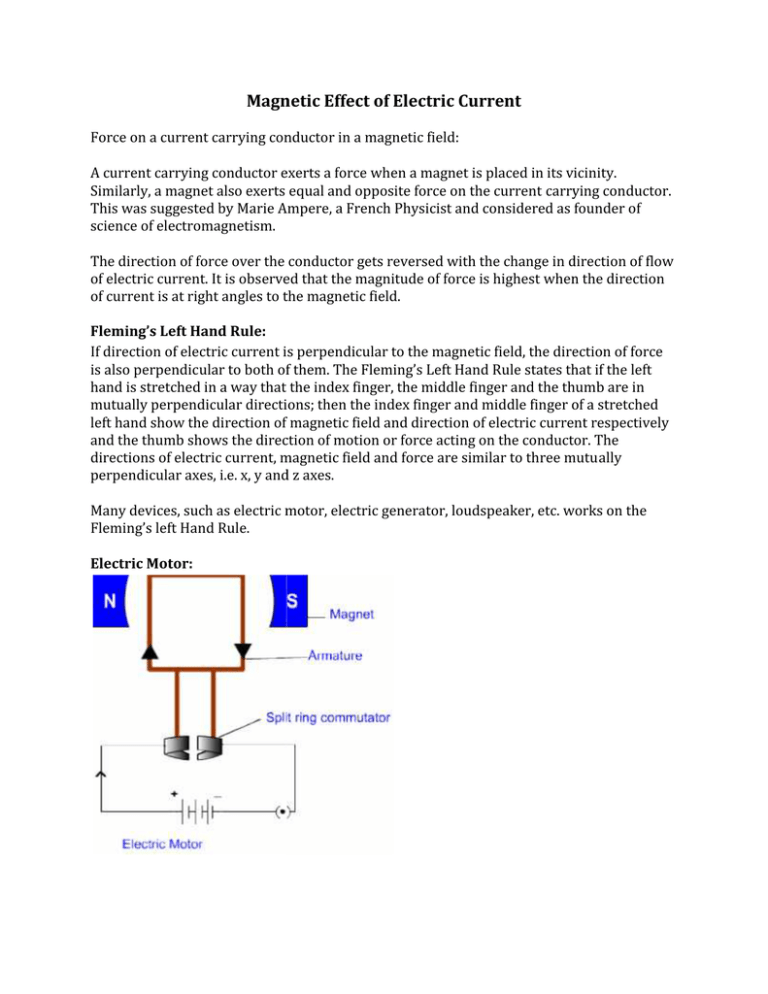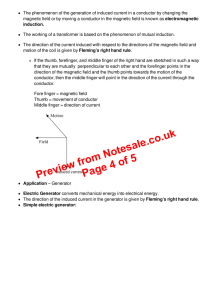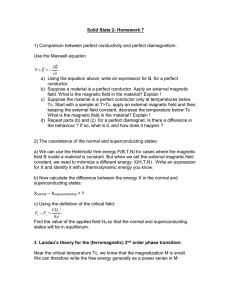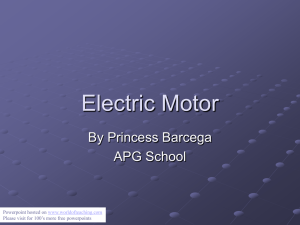Electromagnetic Induction
advertisement

Magnetic Effect of Electric Current Force on a current carrying conductor in a magnetic field: A current carrying conductor exerts a force when a magnet is placed in its vicinity. Similarly, a magnet also exerts equal and opposite force on the current carrying conductor. This was suggested by Marie Ampere, a French Physicist and considered as founder of science of electromagnetism. The direction of force over the conductor gets reversed with the change in direction of flow of electric current. It is observed that the magnitude of force is highest when the direction of current is at right angles to the magnetic field. Fleming’s Left Hand Rule: If direction of electric current is perpendicular to the magnetic field, the direction of force is also perpendicular to both of them. The Fleming’s Left Hand Rule states that if the left hand is stretched in a way that the index finger, the middle finger and the thumb are in mutually perpendicular directions; then the index finger and middle finger of a stretched left hand show the direction of magnetic field and direction of electric current respectively and the thumb shows the direction of motion or force acting on the conductor. The directions of electric current, magnetic field and force are similar to three mutually perpendicular axes, i.e. x, y and z axes. Many devices, such as electric motor, electric generator, loudspeaker, etc. works on the Fleming’s left Hand Rule. Electric Motor: Electrical energy is converted into mechanical energy by using an electric motor. Electric motor works on the basis of rule suggested by Marie Ampere and Fleming’s Left Hand Rule. In an electric motor, a rectangular coil is suspended between the two poles of a magnetic field. The electric supply to the coil is connected with a commutator. Commutator is a device which reverses the direction of flow of electric current through a circuit. When electric current is supplied to the coil of electric motor, it gets deflected because of magnetic field. As it reaches the half way, the split ring which acts as commutator reverses the direction of flow of electric current. Reversal of direction of current reverses the direction of forces acting on the coil. The change in direction of force pushes the coil; and it moves another half turn. Thus, the coil completes one rotation around the axle. Continuation of this process keeps the motor in rotation. In commercial motor, electromagnet; instead of permanent magnet; and armature is used. Armature is a soft iron core with large number of conducting wire turns over it. Large number of turns of conducting wire enhances the magnetic field produced by armature. Electromagnetic Induction Michael Faraday, an English Physicist is supposed to have studied the generation of electric current using magnetic field and a conductor. When a conductor is set to move inside a magnetic field or a magnetic field is set to be changing around a conductor, electric current is induced in the conductor. This is just opposite to the exertion of force by a current carrying conductor inside a magnetic field. In other words, when a conductor is brought in relative motion vis-à-vis a magnetic field, a potential difference is induced in it. This is known as electromagnetic induction. Electromagnetic induction can be explained with the help of Fleming’s Right Hand Rule. If the right hand is stretched in a way that the index finger, middle finger and thumb are in mutually perpendicular directions, then the thumb shows the direction of movement of the conductor, index finger shows the direction of magnetic field and the middle finger shows the direction of induced current in the conductor. The directions of movement of conductor, magnetic field and induced current can be compared to three mutually perpendicular axes, i.e. x, y and z axes. The mutually perpendicular directions also point to an important fact that the when the magnetic field and movement of conductor are perpendicular, the magnitude of induced current would be maximum. Electromagnetic induction is used in the conversion of kinetic energy into electrical energy. Electric generator: The structure of electric generator is similar to that of an electric motor. In case of an electric generator a rectangular armature is placed within the magnetic field of a permanent magnet. The armature is attached to wire and is positioned in way that it can move around an axle. When the armature moves within the magnetic field an electric current is induced. The direction of induced current changes, when the armature crosses the halfway mark of its rotation. Thus, the direction of current changes once in every rotation. Due to this, the electric generator usually produces alternate current, i.e. AC. To convert an AC generator into a DC generator, a split ring commutator is used. This helps in producing direct current. AC and DC current: AC – Alternate current: Current in which direction is changed periodically is called Alternate Current. In India, most of the power stations generate alternate current. The direction of current changes after every 1/100 second in India, i.e. the frequency of AC in India is 50 Hz. AC is transmitted upto a long distance without much loss of energy is advantage of AC over DC DC – Direct current: Current that flows in one direction only is called Direct current. Electrochemical cells produce direct current.




